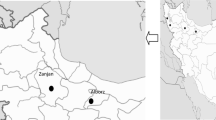Abstract
Salmo trutta is a species of tetraploid origin in the process towards diploidization. By their C-banding pattern, some chromosomes demonstrated homology in the disomic stage, whereas others are tetrasomic. An attempt is made to arrange a karyotype according to this presumptive homology. AsS. irideus (Ohno et al., 1965), andS. salar (Roberts, 1968),S. trutta showed inter- and intra-individual Robertsonian variation. 53 analysed metaphases showed chromosome counts ranging from 77 to 82. The chromosome arm count (FN) was found to be consistently 102.
Similar content being viewed by others
References
Arrighi, F. E. &T. C. Hsu (1971). Localization of heterochromatin in human chromosomes.Cytogenetics 10: 81–86.
Craig-Holmes, A. P., F. B. Moore &M. W. Shaw (1973). Polymorphism of human C-band heterochromatin I. Frequency of variants.Am. J. hum. Genet. 25: 181–192.
Klose, J., U. Wolf, H. Hitzeroth, H. Ritter, N. B. Atkin &S. Ohno (1968). Duplication of LDH gene loci by polyploidization in the fish order Clupeiformes.Humangenetik 5: 190–196.
Nygren, A., B. Nilsson &M. Jahnke (1971). Cytological studies in Salmo trutta and Salmo alpinus.Hereditas 67: 259–268.
Ohno, S. (1970). Evolution by Gene Duplication (Springer, Berlin, Heidelberg, New York 1970).
Ohno, S. (1970). The enormous diversity in genome sizes of fish as a reflection of nature's extensive experiments with gene duplication.Trans. Am. Fish Soc. 99: 120–130.
Ohno, S., C. Stenius, E. Faisst &M. T. Zenzes (1965). Post-zygotic chromosomal rearrangements in rainbow trout (Salmo irideus Gibbons).Cytogenetics 4: 117–129.
Ohno, S., U. Wolf &N. B. Atkin (1968). Evolution from fish to mammals by gene duplication.Hereditas 59: 169–187.
Ohno, S., J. Muramoto, J. Klein &N. B. Atkin (1969). Diploid-tetraploid relationship in Clupeoid and Salmonoid fish. In: Chromosomes Today (C. D. Darlington and K. R. Lewis, eds.), Vol. II, 139–147. (Oliver and Boyd, Edinburgh).
Roberts, F. L. (1968). Chromosomal polymorphism in North American landlocked Salmo salar.Can. J. Genet. Cytol. 10: 865–875.
Roberts, F. L. (1970). Atlantic salmon (Salmo salar) chromosomes and speciation.Trans. Am. Fish. Soc. 99: 105–111.
Soudek, D., R. Laxova &R. Adamek (1968). Pericentric inversion in a family with a 21/22 translocation.Cytogenetics 7: 108–117.
Svärdson, G. (1945). Chromosome studies on Salmonidae.Rep. Swed. State Inst. Freshwater Fish. Res. 23: 1–151.
Wolf, U., W. Engel &J. Faust (1970). Zum Mechanismus der Diploidisierung in der Wirbeltierevolution: Koexistenz von tetrasomen und disomen Genloci der Isocitrat-Dehydrogenasen bei der Regenbogenforelle (Salmo irideus).Humangenetik 9: 150–156.
Author information
Authors and Affiliations
Rights and permissions
About this article
Cite this article
Zenzes, M.T., Voiculescu, I. C-banding patterns inSalmo trutta, a species of tetraploid origin. Genetica 45, 531–536 (1975). https://doi.org/10.1007/BF01772875
Received:
Accepted:
Issue Date:
DOI: https://doi.org/10.1007/BF01772875




